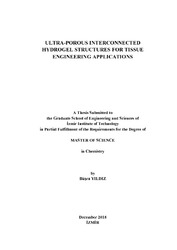Please use this identifier to cite or link to this item:
https://hdl.handle.net/11147/7162Full metadata record
| DC Field | Value | Language |
|---|---|---|
| dc.contributor.advisor | Yıldız, Ümit Hakan | |
| dc.contributor.advisor | Arslan Yıldız, Ahu | |
| dc.contributor.author | Yıldız, Büşra | - |
| dc.date.accessioned | 2019-07-11T11:20:59Z | |
| dc.date.available | 2019-07-11T11:20:59Z | |
| dc.date.issued | 2018-12 | en_US |
| dc.identifier.citation | Yıldız, B. (2018). Ultra-porous interconnected hydrogel structures for tissue engineering applications. Unpublished master's thesis, İzmir Institute of Technology, İzmir, Turkey | en_US |
| dc.identifier.uri | https://hdl.handle.net/11147/7162 | |
| dc.description | Thesis (Master)--Izmir Institute of Technology, Chemistry, Izmir, 2018 | en_US |
| dc.description | Includes bibliographical references (leaves: 48-59) | en_US |
| dc.description | Text in English; Abstract: Turkish and English | en_US |
| dc.description.abstract | Tissue engineering aims to repair and regenerate tissue and organs with functional defects. The most significant developments in tissue engineering emerging as modification of the scaffold used to mimic native extracellular matrix (ECM) and support cell proliferation and differentiation. Hydrogel-based biomaterials are one of the most utilized materials as scaffold providing excellent chemical, physical/biophysical properties, high biocompatibility and functionality necessary for the applications in tissue engineering. In this study, Gelatin methacryloyl hydrogel (GelMA) and Gelatin-urethane hydrogels (GelatinK) are successfully synthesized as scaffold material for tissue engineering applications. Gelatin is modified with methacrylic anhydride for GelMA polymer and with 2-isocyanatoethly methacrylate for GelatinK polymer. The hydrogels of these two novel polymer are produced with photopolymerization reactions in aqueous media using Irgacure 2959 as redox initiator. Hydrogels are freeze-dried to remove solvent in the gel matrix and then they immersed in distilled water to reach equilibrium swelling ratio. The swelling capacity of GelMA hydrogels ranges between 1200 and 300% whereas GelatinK hydrogels has swelling capacity in between 1900-380%. Also, morphology of the hydrogels were investigated with Scanning Electron Microscopy (SEM). GelMA hydrogels has pore sizes between 142-14 µm while GelatinK hydrogels has between 160-56 µm pore sizes. The cell viability assay were also conducted using GelMA and GelatinK hydrogels. The results showed that both hydrogels provide high viability as compared to 2D control assay. | en_US |
| dc.format.extent | xi, 59 leaves | en_US |
| dc.language.iso | en | en_US |
| dc.publisher | Izmir Institute of Technology | en_US |
| dc.rights | info:eu-repo/semantics/openAccess | en_US |
| dc.subject | Hydrogel | en_US |
| dc.subject | Gelatin methacryloyl hydrogel (GelMA) | en_US |
| dc.subject | Tissue engineering | en_US |
| dc.subject | Photopolymerization | en_US |
| dc.title | Ultra-porous interconnected hydrogel structures for tissue engineering applications | en_US |
| dc.title.alternative | Doku mühendisliği uygulamaları için birbirine bağlı aşırı gözenekli hidrojen yapılar | en_US |
| dc.type | Master Thesis | en_US |
| dc.institutionauthor | Yıldız, Büşra | - |
| dc.department | Thesis (Master)--İzmir Institute of Technology, Chemistry | en_US |
| dc.relation.publicationcategory | Tez | en_US |
| item.grantfulltext | open | - |
| item.openairecristype | http://purl.org/coar/resource_type/c_18cf | - |
| item.cerifentitytype | Publications | - |
| item.openairetype | Master Thesis | - |
| item.languageiso639-1 | en | - |
| item.fulltext | With Fulltext | - |
| Appears in Collections: | Master Degree / Yüksek Lisans Tezleri | |
Files in This Item:
| File | Description | Size | Format | |
|---|---|---|---|---|
| T001842.pdf | MasterThesis | 19.08 MB | Adobe PDF |  View/Open |
CORE Recommender
Page view(s)
228
checked on Apr 22, 2024
Download(s)
216
checked on Apr 22, 2024
Google ScholarTM
Check
Items in GCRIS Repository are protected by copyright, with all rights reserved, unless otherwise indicated.